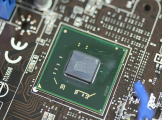The chipset is an important part of the motherboard. It refers to a complete type of chip composed of several microchips, which is responsible for connecting the computer's processor and other parts so that data can be exchanged.
The differences in motherboard chipsets are mainly reflected in the following aspects:
1. Supported CPU models: Different chipsets may support cpus of different generations. For example, the Z series supports processors of the 8th generation and above, while the B series supports processors of the 7th generation and below.
2. Memory support: Different chipsets may support different types of memory, frequencies, and maximum capacities.
3. PCIe expansion capability: The number of PCIe channels provided by the chipset determines the number of expansion cards that can be installed.
4. Storage interface: Different chipsets may support different storage interfaces, such as SATA III, M.2, U.2, etc.
5. Overclocking function: Different chipsets may be more compatible with specific operating systems or hardware expansion devices, providing more I/O interfaces and expansion slots. These differences are very important for users to choose the right motherboard and CPU, as they directly affect the performance and scalability of the system.


Contact: Tom
Phone: 86 18933248858
E-mail: tom@angxunmb.com
Whatsapp:86 18933248858
Add: Floor 301 401 501, Building 3, Huaguan Industrial Park,No.63, Zhangqi Road, Guixiang Community, Guanlan Street,Longhua District,Shenzhen,Guangdong,China
We chat
